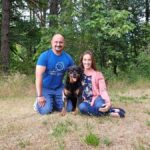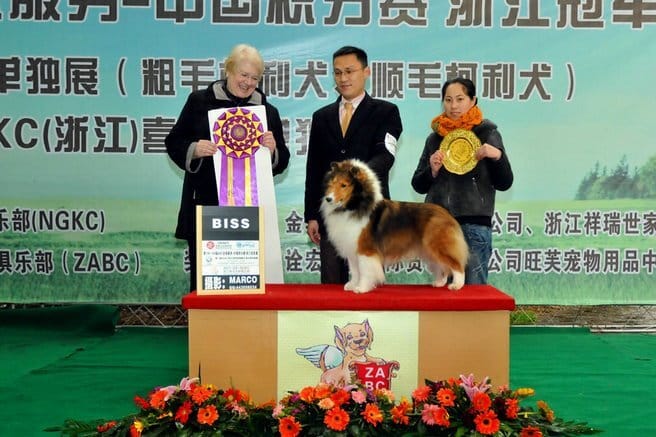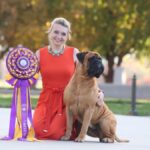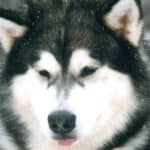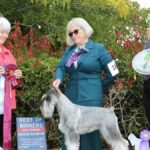Interview with Herding Group Judge Sharon Redmer
I entered the sport of dogs in 1969, training an “All-American” shelter rescue. My first Belgian Tervuren earned a UDT with multiple High in Trials. I went on to become an Obedience Judge (almost 40 years), and a Conformation Judge (30 years).
I judge the Herding, Working, and Sporting Groups, five Non-Sporting Breeds and one Terrier, plus Obedience, Rally, and Juniors. During the pandemic, I became one of AKC’s Virtual Obedience and Rally Judges. I have judged conformation on four continents, plus many National Specialties for my own Belgian breeds and other Herding breeds. In 2016, I became the first judge of the Westminster Kennel Club Masters Obedience Championship. AKC honored me with the 2014 Lifetime Achievement Award.
I currently chair Judges Education for the American Belgian Tervuren Club and I am an Honorary Life Member of the Ann Arbor Kennel Club and Ann Arbor Dog Training Club.
My husband, Ed, and I have bred Tervuren for over 40 years; 150-plus StarBright Tervuren have earned CHs and GR CHs, OTCHs, MACHs, HTCHs, and CTs, Obedience/Rally/Tracking/Herding titles, All-Breed Bests in Show and National wins, and Group Placements. We currently share our home with three Terv bitches and one boss kitty named “Hana the Horrible.”
Where do I live? How many years in dogs? How many years as a judge?
Sharon Redmer: I live in Whitmore Lake, Michigan, just north of Ann Arbor on 11 acres in the countryside. I obtained my first dog, a Poodle/Schnauzer cross, from the local Humane Society as a 9-week-old puppy in 1969. I took her to Obedience classes at the Ann Arbor Dog Training Club and saw my first Belgian Tervuren there, owned by my instructors, David and Kay Maves, Sunfire Tervuren. I was absolutely hooked. My first Terv came into our home in 1972. It is the only breed we have ever owned/bred. We currently share our home with three Tervuren bitches, two ten-year-olds and a rather spoiled 7-month-old. I have been a judge for nearly 40 years (OMG!) as an Obedience Judge; and 30 as a Breed Judge
What is my original breed? What is/was my kennel name?
Sharon Redmer: My original breed is the Belgian Tervuren. StarBright is our kennel name.
Can I list a few of the notable dogs I’ve bred?
Sharon Redmer: We have focused on breeding for versatility—dogs that can pretty much do anything their owners ask of them. As a result, we have produced:
- More than 150 Champion Tervs, many also titled with Obedience, Agility, Herding, Tracking, and Rally Championships.
- Multiple BISS/BOSS winners at the Terv National Specialty, multiple All-Breed BIS and Group Winners, Perfect 200 Obedience Trial winners, and multiple High in Trial dogs in Herding, Obedience, Rally.
- Three littermates who were all either BOB or BOS at the Tervuren National AND All-Breed Group Winners: BIS BISS GCHB OTCH MACH StarBright Casino Royale VCD3 UDX3 OM5 RE BAR; BISS GCHB StarBright Bettin’ On The River CD RN CGC; and BOSS GCHG StarBright Winning Bet BN RN.
- The first CH Tracker of the breed; CH CT StarBright Je Ne Sais Quoi CDX HT
We have been blessed with great bitches who produced generation after generation of multi-talented, multi-titled StarBright Tervs: CH StarBright Bouquetiere CD TD BAR; CH StarBright Fait Accompli TDX BAR; CH StarBright Jalapeno BAR; CH StarBright Kachina CDX BAR; CH StarBright Mille Fleurs CDX BAR; CH StarBright Mata Hari TD BAR; and CH StarBright Cinema Quick Pick CDX, RN BAR.
Additionally, we were fortunate to partner with other breeders to import from top kennels in Belgium (van de Hoge Laer, Grimmendans), France (La Clairiere aux Louves, Val Myrak) and England (Domburg, Belamba, Branock) to bring in qualities desperately needed in our breeding program at the time.
Any performance or parent club titles?
Sharon Redmer: Yes, 18 StarBright Tervuren have earned the American Belgian Tervuren Club’s top producer awards, called the BAR, in Conformation, Performance, and Obedience/Tracking.
What are the qualities I most admire in the Herding breeds?
Sharon Redmer: Biddability/Trainability/Willingness to Please. I love the Dog/Human bond that we see so consistently in the Herding breeds. Honestly, there are many times I KNOW our dogs are smarter than we are… and pretty much any owner of the Belgians (and most other Herding breeds) will admit to the same thing. Our Herding Dogs need to be independent thinkers yet work in partnership. They need to instinctively “react” to stock when working. Sadly, it is NOT uncommon for that reactivity to be too highly developed… one consistent criticism from many judges who did not grow up in the Herding breeds. In those breeds where you can readily see eyes/expression, I want to see a dog who is “in there” looking back at me with interest.
Have I judged any Herding Group Specialties?
Sharon Redmer: I have judged pretty much all of them at this point in my judging career. It is a singular honor to be invited to judge at a Herding Group Specialty. And after National Specialties, it is my most enjoyable judging experience.
Do I find that size, proportion, and substance are correct in most Herding breeds?
Sharon Redmer: Oh, don’t we all wish! I think breeders are honestly trying to breed to their standards, but some proportions are just a bit harder to achieve and maintain. Those breeders who are producing square dogs KNOW how difficult it is to achieve that square silhouette and have correct angles, front and rear, that create proper gait for the breed. It is ever so much easier to produce an animal off-square (in pure geometric terms this is correctly described as a rectangle, folks!) whose proportions allow for forgiveness in gait when there are imbalances in angulation front/rear. Size… I am noticing a few of the small-to-moderate-sized Herding breeds beginning to get too much size. Measuring those breeds with DQs for height needs to be more consistently applied.
Is breed-specific presentation important to me as a judge? Can I offer some examples?
Sharon Redmer: BUT, OF COURSE! What I never ever understand is why exhibitors who own breeds where head proportions, eyes, and ears are NOT covered by an abundance of long hair, cords or flocks consistently bait their dogs so high that it creates the illusion of a short neck from the side. Bait your dog upwards when the judge is right there looking at expression. And for heaven’s sake, let it come to a more natural position when the judge is standing back, looking at the silhouette and proportions. Overgrooming, trimming, and sculpting can be seen every weekend at the shows. Certain breed standards are pristinely clear about how all of that excess grooming, fluffing, and trimming is to be penalized.
What about breed-specific movement? Do I demand this from Herding Dogs?
Sharon Redmer: AGAIN, Of course! For example, a Border Collie should always be moved on a loose lead, allowing the head to plane forward to be level with or slightly below the withers. German Shepherd Dogs should move with coordination and balance, feet carried close to the ground; an effortless ground-covering gait. The section on Gait in the GSD standard is incredibly well-written and creates a clear picture of a long stride, front and rear. Unfortunately, they are often judged in postage stamp-sized rings. (And by the way, this gait is seldom enhanced by double-handling and is frequently destroyed by it.) I expect to see OES moved from a walk to a trot, and not penalize an amble or pace. The Corgis do not move in exact parallel planes, but do incline slightly inward to compensate for shortness of leg and width of chest. Pyrenean Shepherds have one of my favorite descriptions of gait; they “shave the earth” with feet barely leaving the ground. Most of the square Herding breeds ask for some combination of effortless gait; smooth, free and easy… covering maximum ground with minimal steps. In all breeds, FASTER is not better, and racing around the ring often creates what my mother would term a “Mixmaster” (think old-timey eggbeater), a kind of scuttling/scurrying gait; unattractive and incorrect for any Herding breed.
Are the Herding breeds in good shape overall? Any concerns?
Sharon Redmer: Reasonably so. Within the Herding Group we have MANY low entry breeds. Even some of the previously huge entry breeds have slipped down to low entry status. That is not to say that one cannot find excellent dogs in the low entry breeds. Au contraire! But it does mean that some Herding breeds have fewer good (dare I say, great) examples of the breed out there competing. Of course, there are pockets of beautiful dogs of individual breeds across the various parts of our country.
In my opinion, how do today’s exhibits compare with the Herding Dogs of the past?
Sharon Redmer: LOL! On the days when I am judging Herding breeds and I have wonderful dogs, I think, “Gosh this breed has come a long way—well done!!” On the days where every entry is a struggle to rate because there is no depth of quality, I think, “NO…our Herding Dogs are going in the wrong direction.”
Change in breeds is rather inevitable. That said, there are several Herding breeds which seem to be in fabulous shape. Just my opinion, of course, but as one example, the overall quality of the Aussies is truly impressive. The retirement of so many Herding Dog breeders is hitting some breeds hard… but this is true in Sporting and Working Dogs too. The sport of dogs, in general, needs young, smart, passionate breeders to come forward to focus on breeding outstanding dogs… Herding Dogs are no exception. Be kind to those new breeders, they are the future of your breed!
Why do I think Herding Dogs can often become outstanding Show Dogs?
Sharon Redmer: Because of their “awareness” of everything, Herding breeds have some challenges to overcome to become great show dogs. That said, as an owner, there is nothing like a Herding Dog to make you feel like the most important person on earth. We have had many fabulous, top show dogs in the Herding Group (GSDs, Aussies, Beardies, Shelties, Collies, Corgis, Bouvs, Pulik, and OES, in particular) winning top-billing year after year in the Group. AND YES, there are wonderful examples of other Herding breeds being top show dogs as well. What do they have in common… maybe an innate willingness to work with their owner, to please their human?
Just for laughs, do I have a funny story that I can share about my experiences judging the Herding Group?
Sharon Redmer: I can think of two in particular with Herding breeds.
One incident occurred when I was judging my own Terv National in 1996. A lovely young bitch was gaited down and back, beautifully shown by her owner. However, upon returning to the judge, the bitch turned her rump to me. The handler stood back with a loose lead, trying to get her bitch to turn and give me an ear lift or two. When bait failed, she repeatedly chanted, “Where’s the cow? Where’s the cow?” Trying to get her bitch to turn, SHE WAS POINTING DIRECTLY AT ME with each “COW!” I couldn’t resist… I said (with a smile) to the handler: “Madam, are you referring to me as a cow?” whereupon the handler, without missing a beat, pointed in the exact opposite direction, repeating, “Where’s the cow?” Never did get to see any ears on that youngster.
Judging at a National Specialty where a full bite/tooth exam was required, one gentleman, who clearly spoke limited English, showed a lovely male with soft eyes and a very correct expression. After examining the dog and coming back to the head, I requested that the handler “show me the bite” whereupon the handler appeared horrified and stated repeatedly, “NO BITE, NO BITE, NO BITE,” each time louder and more vehement than the previous. Then he said, “GOOD DOG, GOOD DOG, GOOD DOG,” trying to convince me that this was a Good Dog who DID NOT BITE! A ringside observer finally intervened with a quick translation and, indeed, I got to see the dog’s bite/teeth, all the while the handler chanted, “GOOD DOG, GOOD DOG, GOOD DOG.” Gotta love this sport!
